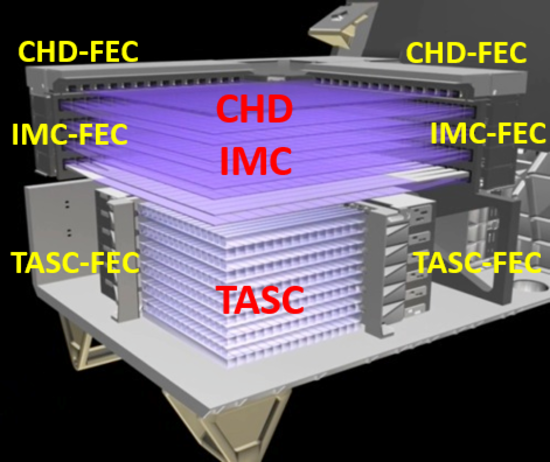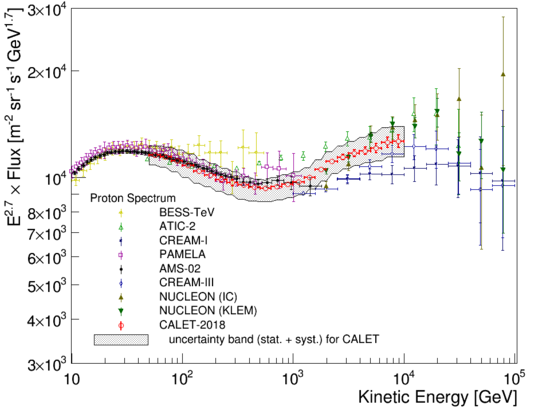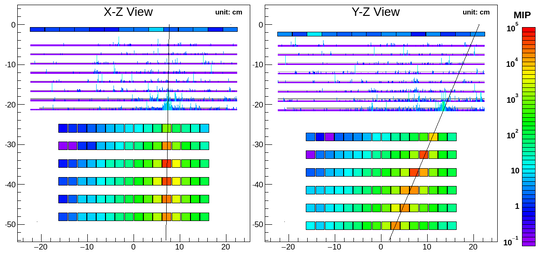This is an archive of information released in the past.
Disclaimer: It may contain broken links or outdated information. Some parts may not function in current web browsers.
*Visit https://humans-in-space.jaxa.jp/en/ for the latest information.

Experiment
- News
- Kibo Utilization Strategy
- Kibo Utilization Plan
- List of JAXA's Utilization Themes
- Experiment Facilities
- Space Environment Utilization
- Archive
Detection of progressive hardening of the cosmic-ray proton spectrum up to teraelectronvolt energies with direct measurements by CALET on the International Space Station
Japan Aerospace Exploration Agency (JAXA)
Waseda University
A team of researchers led by Yoichi Asaoka, senior researcher of Waseda Research Institute for Science and Engineering, Waseda University; Shoji Torii, emeritus professor of Waseda University and Principal Investigator of CALET; and Pier S. Marrocchesi, Professor of Siena University report a progressive spectral hardening of cosmic-ray protons, the primary component of galactic cosmic rays, precisely measured over the energy range 50 GeV - 10 TeV using the CALorimetric Electron Telescope (CALET). CALET is a deep electromagnetic calorimeter continuously observing cosmic rays and gamma rays from the Japanese Experiment Module (JEM/"Kibo") - Exposed Facility on the International Space Station (ISS). The CALET project is sponsored by the Japan Aerospace Exploration Agency (JAXA) with support from other Japanese organizations, the Italian Space Agency (ASI) in Italy, and the National Aeronautics and Space Administration (NASA) in the U.S.
Direct observations of the proton spectrum [2,3] with CALET provide the first continuous flux measurement over the wide 50 GeV - 10 TeV [1] energy range with a single instrument. The observed spectral hardening [4] for protons limits current models for acceleration [2] and propagation of galactic cosmic rays proposed to explain previously observed spectral hardening of cosmic-ray nuclei. The result is published in the Physical Review Letters journal and featured in the "Editor's Suggestions" highlights for the issue. Cosmic rays have been at the forefront of physics since their discovery in the early 20th century. Based on the work and observations of many scientists, a general consensus has formed that cosmic rays are accelerated by shock waves in supernova remnants, diffusively propagate in the galactic magnetic field, and subsequently leak out of the galaxy. In the early 21th century, magnetic spectrometers extended the energy reach of high precision of direct measurements of cosmic rays. These developments yielded the first detection of the hardening in the spectra of cosmic-ray nuclei. The hardening of the spectrum is not expected based on the standard model of cosmic rays, and its interpretation has become an important topic of current research.
Instruments which measure cosmic rays in the CALET energy range fall into two general categories: magnetic spectrometers (e.g. BESS-TeV, PAMELA, AMS-02), which measure the rigidity of a particle by the curvature of its trajectory in a strong magnetic field, and calorimeters (e.g. ATIC, CREAM, NUCLEON), which measure the energy of a particle directly through its absorption in dense materials. Current generation magnetic spectrometers in space are limited to a maximum detectable rigidity with an equivalent energy of roughly 1 TeV for protons. Balloon-borne calorimeters are able to detect particles of higher energies, but had relatively large variations due to the intrinsic difficulty in this measurement. Compared to high-precision measurement up to about 1 TeV using a magnetic spectrometer, it can be said that it was difficult to comprehensively understand the entire spectrum. The CALET result has resolved this long-standing concern and allows scientists to draw a consistent experimental picture. Beyond the primary science result, a reliable measurement of the cosmic-ray proton spectrum is necessary as a reference for understanding a dominant background source in indirect searches for dark matter, observation of atmospheric and cosmic neutrinos, and gamma-ray astronomy.
This research result was published on May 11, 2019 in the online edition of the international journal "Physical Review Letters".
- Direct Measurement of the Cosmic-Ray Proton Spectrum from 50 GeV to 10 TeV with the Calorimetric Electron Telescope on the International Space Station
- CALorimetric Electron Telescope (CALET)
CALET was installed on Kibo in August 2015 and started high-energy cosmic-ray observation in October of the same year. CALET is the first Japan-led, long-term, large-scale space experiment for cosmic-ray observations.
Digest of science results
(1) What we have known from previous studies (Scientific background)
Study of the charged cosmic rays is essential to the ultimate understanding of high-energy radiation in the universe, including X-rays and gamma rays. At lower energies (i.e. radar, infrared, visible light) photons are generated in thermal processes with a spectrum well-represented as a blackbody with a characteristic temperature. X-rays and especially gamma rays are predominantly created instead as secondary particles in the interaction of cosmic-ray electrons and hadrons, providing a window to the sites where these particles originate. For this reason, cosmic rays are responsible for the non-thermal radiation seen at high energies with characteristic power-law spectra.
Direct observation of the galactic cosmic rays arriving at the Earth require instrumentation at high altitude with little or no atmosphere to disturb the incident particles. Various balloon-borne calorimetric instruments have been developed in Japan and abroad, and the results of these instruments were indispensable to the construction of the standard paradigm of cosmic-ray acceleration in supernova remnants, diffusive propagation in the galactic magnetic field, and eventual escape from the galaxy.
High-precision observations have been performed since the early 21st century by magnetic spectrometers on balloons and in space using the particle detection technologies developed for collider accelerator experiments. As a result, spectral hardening [4] not predicted by the standard model of cosmic rays described above was observed in the fluxes of cosmic-ray nuclei. Many theoretical models have been proposed which introduce new hypotheses on the acceleration and propagation of cosmic rays and active discussions are ongoing.
(2) What is elucidated by this research
Protons are the dominant species in galactic cosmic rays and have been studied in great detail to understand the high-energy radiations in the universe. Measurements of the cosmic-ray proton spectrum deviated by a factor of 2 in early experiments. Consistency was first reached by the BESS balloon experiment and space observation by AMS-01 onboard a space shuttle. Thereafter, the proton flux up to several tens of GeV [1] was established by precise measurements with magnetic spectrometers.
In the past decade, both the PAMELA satellite and AMS-02 on the ISS detected spectral hardening in protons with energies of hundreds of GeV. Further spectral hardening was suggested by balloon-borne calorimeters (e.g. ATIC, CREAM) for high-energy observations, but considerable variations between experiments exist large due to the difficulty in energy determination and other corrections. In terms of the spectral index of protons, an important quantity for constraining models, the calorimeters extending to high energies suggested a larger change than shown by the magnetic spectrometers. However, the lack of overlap in the energy ranges covered means that consistency between the different experiments has been impossible to verify, leaving room for systematic uncertainties in the energy scales reported. CALET resolves this uncertainty by successfully observing the full energy range covered by the magnetic spectrometers and calorimeters with high accuracy in a single experiment with reliable energy measurement and instrument calibration.
(3) Newly developed methods
CALET is a cosmic-ray electron telescope that was installed on the Exposed Facility of the Japanese Experiment Module "Kibo" on the ISS in August 2015 and started observation in October of the same year. It is the first large-scale space experiment in Japan and is scheduled to observe for more than 5 years. Although the instrument is optimized for high-precision measurement of high-energy electrons, it also contributes valuable measurements of cosmic-ray protons and nuclei due to its reliable charge determination and wide energy coverage. The main detector on CALET is the calorimeter, which stops and absorbs the cosmic rays that are incident on it. The calorimeter is made up of three detectors shown in Fig 1.

Fig 1. A schematic view of the CALET calorimeter, including the Charge Detector (CHD), Imaging Calorimeter (IMC), and Total Absorption Calorimeter (TASC).
(Credit: JAXA/Waseda University)
In the first subdetector, the Charge Detector (CHD), the absolute charge of the incident particle is measured and the atomic number is determined. Just below the CHD, the Imaging Calorimeter (IMC) measures the arrival direction of the particle. In the third and thickest layer, the Total Absorption Calorimeter (TASC), the energy and particle type (i.e. electron-like vs. hadron) through direct absorption of the shower of secondary particles that result from instruments. By combining the information from the three subdetectors, the type, absolute charge, energy, and arrival direction of each event is characterized. The composition, thickness, and multiple gain-range readout of the TASC give CALET a particularly large dynamic range of observable deposited energies.
Fig 2. shows a proton candidate event with energy in the TeV range. A proton incident on the upper layers causes a shower in the instrument due to nuclear and electromagnetic interactions, and the shower energy is measured in the TASC. Although leakage of energy from the instrument increases with increasing incident particle energy (unlike electrons, whose energy is absorbed almost entirely), the shower energy measurement is very accurate and the response of the detector is uniform even at TeV energies. This is an important distinguishing feature from magnetic spectrometers.
(4) Results and knowledge obtained from this study
Fig 3. shows the proton spectrum measured by CALET over the time period from October 13, 2015 to August 31, 2018 (red dots). The gray band shows the total (statistical and systematic) error on the measurement.
The electron measurement by CALET, with efficient containment of the particle energy in the TASC, and the proton measurement by AMS-02, which determines momentum from the trajectory curvature of particles in a magnetic field, are the most direct and reliable methods in direct observations of cosmic rays. On the other hand, while the measurement of protons with a calorimeter has its own advantages, the analysis and characterization of systematic effects is very difficult. The CALET results in this study include a detailed evaluation of their systematic errors and are in good agreement with the high-precision measurements from magnetic spectrometers in the sub-TeV energy range. While the energy range observed by CALET has been covered separately by magnetic spectrometers and balloon-borne calorimeters, this result represents the first measurement over the full energy range with a single detector. The ability to compare the results of the analysis below 1 TeV and to establish the consistency with precision spectrometer measurements increases confidence in the CALET result compared to existing measurements. The reliable measurement of the cosmic-ray proton spectrum is important for understanding the physics of cosmic-ray acceleration and transport in the galaxy. Furthermore, it is an important reference of the dominant background source for indirect searches of dark matter, atmospheric and cosmic neutrinos, and gamma-ray astronomy.

Fig 3. Cosmic-ray proton spectrum measured by CALET in the energy range of 50 GeV to 10 TeV. In order to investigate in detail the spectral structure of the flux that rapidly decreases as the energy increases, the energy to 2.7 is multiplied to the vertical axis. Among previous observations, the measurement results with magnetic spectrometers (BESS-TeV, PAMELA, AMS-02) and t with calorimeters (ATIC, CREAM, NUCLEON) are shown together for comparison. (Credit: Waseda University)
(5) Broader impacts and social impact of research
CALET's observations have attracted a lot of interest from Japan and abroad. Dark matter, one of the greatest mysteries of the universe and a science topic for CALET, has been featured in newspapers, magazines, and in the NHK BS and international National Geographic. Thus through this increased interest, the observations reaffirm the significance of the Japanese Experiment Module on the ISS in addition to the scientific value of the results themselves.
(6) Future plans
Regarding "spectral hardening", helium and heavy nuclei (CNO, etc.) also suggest power-law index changes in the region of several hundred GeV per nucleon. Following the proton results, CALET will also present calorimetric high-precision measurements of these nuclei.
The softening of the spectrum [5] of cosmic-rays observed by ground-based indirect measurements, the "knee" in the spectrum, suggests that the acceleration limit is near 3 PeV and that the cosmic-ray composition shifts from light nuclei to heavier elements above the energy. On the other hand, the typical model for galactic cosmic rays of shock wave acceleration in supernova remnants predicts an acceleration limit proportional to particle charge and the highest energy achievable with current model is typically estimated to be 60 TeV for protons.
CALET will measure the spectra of protons and helium to 100 TeV range over more than 5 years of observation to search for a cutoff corresponding to the acceleration limit. This will be a direct verification of shock wave acceleration with supernova remnants. On the other hand, if the acceleration limit is not observed and the power spectrum extends to the 100 TeV range, it would also be a very important result, demonstrating that the acceleration limit has actually increased due to magnetic field amplification and/or other effects in the vicinity of the shock wave.
(7) Glossary
- [1] Electron volt
This is a unit of energy. The energy gained by electrons when they pass through a potential difference of 1 volt without resistance is 1 electron volt (eV). For reference, a blue photon has energy of approximately 3 eV. Here we are dealing with the energy range of109 times (GeV), 1012 times (TeV) and 1015 times (PeV) higher than 1eV. - [2] Cosmic-ray acceleration
One of the most compelling theories to explain where the high-energy cosmic rays come from and how they have been accelerated is in supernova explosions. A supernova is the explosion of the massive stars occurring at the end of their life that generates enormous amounts of energy. We consider that particles accelerated by these explosions are the high-energy cosmic rays originating in our galaxy. However, the detailed mechanisms of how to accelerate these particles are not yet fully understood. - [3] Spectrum
In this article, the term "spectrum" is always used to mean energy spectrum. A figure with energy on the horizontal axis and flux on the vertical axis is called the energy spectrum. The cosmic-ray spectrum has a power-law shape, with power-low index usually around -2.7, meaning that the flux decreases rapidly as the energy increases. - [4] Spectral hardening
This represents the spectral index change in the direction to decrease the absolute value of the power-law index, indicating that the rate of decrease in flux with respect to energy is decreasing. - [5] Spectrum softening
Contrary to spectral hardening, this represents the spectral index change in the direction to increase the absolute value of the power-law index, and indicates that the rate of decrease in flux with respect to energy is increasing.
(8) Reference
- Journal title: Physical Review Letters 122, 181102, 2019 (Highlighted as Editor's Suggestion)
- Letter title: Direct Measurement of the Cosmic-Ray Proton Spectrum from 50 GeV to 10 TeV with the Calorimetric Electron Telescope on the International Space Station
- Authors: O. Adriani et al. (CALET Collaboration)
- Corresponding Authors: Y. Asaoka, P.S. Marrocchesi, and S. Torii
- DOI: 10.1103/PhysRevLett.122.181102
- Publication on paper: Volume 122, Issue 18, 10 May 2019
Related topics
- CALET Gamm-ray observation results are featured in on-line version of The Astrophysical Journal (November 2, 2018)
- CALET succeeds in direct measurements of cosmic-ray electron spectrum up to 4.8 TeV (July 19, 2018) (Link to WASEDA Univ. website)
- The First Detection in Space of 3 TeV Cosmic Ray Electrons in a High-Precision Measurement of the Electron Energy Spectrum by CALET on the International Space Station (November 7, 2017)
*All times are Japan Standard Time (JST)
| Copyright 2007 Japan Aerospace Exploration Agency | Site Policy |
